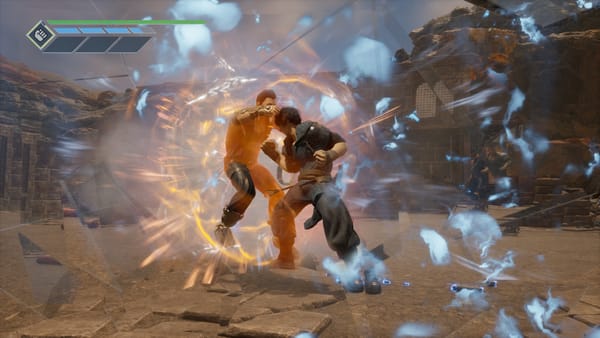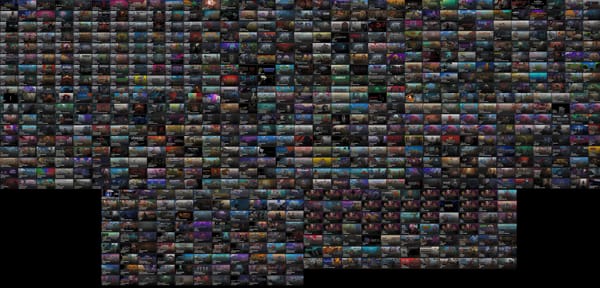#110: On balance
And the difference between what players say, and what they really mean.
[Thanks for reading Hit Points! If this is your first time, then a hearty welcome to you. If you enjoy today’s edition, note that you can sign up for free to get this twice-weekly look at the latest goings on in the game industry sent straight to your inbox. It also gets you access to the full Hit Points archive. Thanks, and enjoy!]
Many years ago, I spent an evening in the pub with a cohort of fellow game journalists. Among them was the wonderful Graham Smith, who these days is doing audience-development stuff I shan’t pretend to understand at Rock Paper Shotgun, but I believe at the time was editor of PC Gamer. I was stressing about something I had to write: a post script for the Edge review of the PS4 launch title Killzone Shadow Fall. I knew I wanted to talk about AI, both in the game and in shooters more broadly, but wasn’t entirely sure what to say or how to say it (I was a fraud, and still am). Graham said something that helped it all click into place, and which I have never forgotten. “People say they want good AI in shooters, but they don’t. If FPS AI was perfect then it would be just like playing online against the people at the top of the leaderboard. It would be awful. When people say they want good AI, what they mean is they want to fight enemies that make them feel smart when they beat them.”
I effectively wrote up that conversation, or at least what I could remember of it through the hangover, and just about made my deadline. But Graham’s words have stuck with me ever since — and not just because, after the issue had gone on sale, a reader emailed to say what a good, thought-provoking piece it was (again: fraud). No, what I took from it was that there is often a difference between what we say or think we want in our games, and what we really mean.
I’ve been thinking about this lately in relation to balance in games, and specifically, unsurprisingly I expect, about balance in Elden Ring. The main trigger for it, apart from my own dozens of hours (and hundreds of deaths) in FromSoft’s latest — and the near-constant stream of videos in my Twitter timeline of pals being one-shot by various enemies in the game — was this thought-provoking sort-of-review from the little-known videogame YouTuber Dunkey. Perhaps you have heard of him.
I am not going to try and disagree with his premise that Elden Ring’s balance often feels extreme. I have been one-shot, both by bosses and rank-and-file enemies, more than enough times to take his point. I got so worn down by the punishing final stretch of the game that I decided to borrow a quite broken, and cleary unintended, strategy from the speedrun community that can turn every boss in the game to mincemeat in a few hits. I felt no shame in doing so — indeed, I think it reinforces the point I am about to try and make — and completed the game last Friday.
But my counterargument is that old line of Graham’s. A ‘balanced’ Elden Ring would not be the same game, and I do not believe that is what Dunkey, or any of us who has seen a full health bar melt away in half a second — or have killed a boss in four hits — are really complaining about, or asking for. As we have discussed in Hit Points before, FromSoft’s games stand out in part because of how disinterested the developer seems in what the game industry considers best practice. Sure, Elden Ring could have a linear difficulty curve. Enemies could grow in power at the same rate you do, scaling to your current level so that Limgrave, Lake Of Rot and the Haligtree would pose a similar level of challenge regardless of how early or late in the game you visited them. Every boss battle could take exactly seven minutes and require the exact same number of hits to kill, or kill you.
But this sounds terrifically boring, does it not? It certainly does not sound like Elden Ring, a game I finished on Friday afternoon and restarted afresh on Sunday night. It sounds like all the other open-world games out there that I have not already written several thousand words about, have not found myself thinking about constantly for the past six weeks, and that have absolutely not got one of the highest average review scores in gaming history. As Spelunky designer Derek Yu is fond of pointing out, balance is often to the detriment of fun. A perfectly balanced game — an immaculate sort of playable spreadsheet where everything just feels fair — might be something to admire, but it is unlikely to be all that fun to play.
Dunkey isn’t asking for that sort of balance in Elden Ring, sure. But I think it is the most obvious brute-force solution to a very difficult problem — how to balance difficulty in a game of such size and scope, that offers the player so much freedom in where they go and when, and how they fight when they get there — and explains why we see it so often. It is an even more complex problem for Elden Ring, a game in which it is possible to become terrifically strong even before you start pilfering tactics from the speedrun scene. It adds so much to the FromSoft template — you can craft damaging items, fight on horseback, summon a souped-up copy of yourself, put unique moves on your weapons and have their basic swings inflict status effects, and if all else is lost, respec your character over a dozen times each playthrough — that I sort of understand FromSoft’s lategame rug-pull, where you suddenly feel as weak as a kitten again despite your enormous health bar and maxed-out arsenal. How do you balance enemies around a player with all that power in their pockets? Okay, one-shotting them is a bit extreme, but this is FromSoftware we’re talking about. It’s not exactly surprising that Miyazaki and co should find themselves faced with a walnut, let their gaze pass over the nutcracker and the sledgehammer, and reach directly for the nuclear warhead.
This is FromSoft’s whole deal. It does not give with one hand without taking away with the other, and kicking you in the shins at the same time. I interviewed Miyazaki a few E3s back about the newly announced Sekiro: Shadows Die Twice. I asked him about the game’s signature addition to the FromSoft style guide — a resurrection mechanic that let you get back up when you died — and whether players should see it as a sign he was making an easier game this time, or a warning that this one would be even harder. We all know how that turned out. (His reply, by the way, began with a pause, a smile, and the word ‘naisu’. I hadn’t felt that good about myself since the first time I killed Smough and Ornstein.)
Balance is a weird thing, a subjective one, often more about feelings than facts. And a perceived imbalance can ultimately define a game, rather than break it in two. Take, for example, my beloved Street Fighter IV. In its second major revision, 2011’s Arcade Edition, Capcom added a host of new characters, and one of them in particular was clearly overtuned. Yun was busted, really, and early in the game’s life the community was quite upset with Capcom for letting him out of the door in so overpowered a state. Balance is obviously precious in multiplayer games, and while each character in a fighting game has their strengths and weaknesses — certain character matchups that naturally favour them, and others in which they struggle — the community felt Yun had the natural advantage against pretty much the entire cast. There were fears for the health of the game’s thriving tournament scene, and loud calls for Capcom to tone him down.
Series producer Yoshinori Ono demurred, explaining in a Famitsu interview that Yun was working as intended. Ono said he felt that “having such a character [that is stronger than the rest] helps to build a community and competitive spirit.” I thought this was bollocks at the time, just an excuse for a mistake that Capcom had made, but history has proven Ono right. The SFIV community — or at least, the portion of it that didn’t play Yun — rallied round, coming together to devise ways in which their bête noir’s bonkers toolset could be countered. On the tournament scene, once-beloved players who picked Yun were barracked and cast as the bad guys, the crowd automatically rooting for their underdog opponent. After a couple of years the next major SFIV revision came along, Yun was toned down significantly, and the game and its community moved on. But the legacy of the Yun years endures, and in hindsight I’m glad it happened. SFIV is one of my favourite games of all time, Arcade Edition is a milestone moment in the game’s history, and The Yun Times live on as its most memorable chapter. That experience changed the way I thought about balance, or at least the supposed importance of it.
I see something similar in Elden Ring, and FromSoft’s games more broadly. Technically they are PvE games with an optional — and this time largely opt-in, praise the sun — PvP component. Yet they are not really PvE games at heart, but what I suppose we can call CvE: community versus environment. They are designed to be played not just in cooperation but in communion, encouraging and empowering, at times even forcing, players to come together to solve their many problems: boss strategies, level layouts, item locations, lore, questlines, speedrun routes, all that. If the website guide or YouTube video doesn’t get you past a roadblock, perhaps you can summon a chap with two massive bloody hammers to knock it down for you. There are few problems in Elden Ring that cannot be solved by community brute force, and as such I find it hard to be too upset at the fact that the game appears, at times, to be made entirely of Yuns. I am, after all, a bit of a Yun myself. The final boss could tell you that, if I hadn’t already killed it.
Elden Ring’s difficulty pinches the hardest at the very end. For most of the game, FromSoft uses challenge as a sort of guide; if the first enemy you encounter in an area seems too strong, the developer is suggesting you go somewhere else first (think of the birds in Caelid, and those gits in the ruins at the start of Mountaintop Of The Giants). Similarly, a boss fight that seems impossible is in part designed to tell you that you’re not quite ready to face what lies in wait behind it. And throughout, there is always somewhere else for you to go: an area either entirely unexplored or not yet picked clean, where you can gather Runes for level-ups, perhaps find a new weapon or gear piece that transforms your current build. You can run around an early-game area cathartically one-shotting everything, blowing off some steam.
Late in the game, as Miyazaki and team start to really turn the screw, you’re running out of options. You are at the thin end of the funnel now, the bulk of the game and its sprawling world behind you. It doesn’t help matters that FromSoft stacks the game’s final straight with so many boss fights, reinforcing the sensation that you are running out of escape routes — running out of Elden Ring! — and the walls are all that remains. The pain becomes sharper, but is it really because the game is too hard? Or is it that this is one of the last things in Elden Ring on which you will ever be stuck?
Sure, in the heat of the moment, as the final boss does that grab move I’ll be having nightmares about for months and my health bar evaporates again, I am frustrated. I may use some words that make the eldest shout “Language!” from round the corner. Then the beast finally falls, and elation segues with cruel elegance into sadness; I am happy to have played and loved and finally beaten the thing, but crushed that it is over, like an excellent book or a top-five meal. That, right there, is the hardest balance for game designers to strike. Personally I think that is worth all the one-shot attacks in the world.
Two thousand words, that took, give or take. Dunkey did it in five minutes. Told you I was a fraud, didn’t I.
MAILBAG!_v0.0.01
Substack newsletters have comment sections, you know. I’ve always found it a bit of a weird fit. It’s an email, after all, not a web page. However, did you know you can simply hit reply on any Hit Points email? Your response will be sent right to my inbox, like we’re old-timey pen-pals.
As Hit Points continues to grow and spread its tendrils through the game industry, I am getting some terrific insights, comments and even occasional dad jokes from readers, and some of them are too good to keep to myself. Here, then, is the first instalment of Hit Points’ new occasional series: the all-caps-bolded-up MAILBAG! If you’d like to be featured, you know what to do.
- “Sorry about ‘Happy’,” writes Björn in response to Friday’s E3-themed edition. Turns out he was the Ubisoft whizzkid who came up with the tech that powered Just Dance Now, the game whose tracklist ruined everyone’s E3 — Björn’s included. “That song was driving me mad too. Even worse, later that summer we worked behind closed doors at Apple in Cupertino on the Apple TV launch SKU. We tested that song A LOT on the new remote, and at the end of the week what bright idea did Apple have? They brought in Pharrell Williams to sing it live for us.” Incredible. I’m amazed someone didn’t rush the stage with a big stick.
- “I agree E3 is more than the sum of its parts,” says Roland, a veteran videogame journalist who has been attending the show since the 1990s. “The last two years of ‘E3 online’ were a big joke, some of the videos so bad and boring that even a demo of a C-game at an in-person E3 would have been more interesting.” Indeed. If it ever comes back we must grab that drink.
MORE!
- Activision Blizzard is in hot water again, this time over the sudden cancellation of its company-wide Covid-19 vaccination mandate. It’s already walked it back a little amid uproar from staff, saying it will allow individual studios to set their own rules, but that wasn’t enough to stop some 80 staff staging a walkout over the issue yesterday.
- Ron Gilbert is making a new Monkey Island, suggesting perhaps there’s hope for this sorry timeline yet. Rex Crowle, of Tearaway and Knights & Bikes fame, is also working on the game, which Gilbert announced on April 1, leading people to assume it was a hoax. “I felt bad about the April Fool’s joke,” he said, “so over the weekend I whipped up the game so no one was disappointed.”
- After a year in Early Access, Unreal Engine 5 is officially a thing.
- While we’re still thinking about the apparent death of E3, some further reading: I enjoyed Chris Dring’s take over at GI.biz, and heartily recommend this lovely story from Patrick Klepek, who has attended every year since he was 14. I may have briefly choked up.
There we go! Gosh, what a bumper edition. At least the end bit was quick, eh. As ever, if you’ve enjoyed this, do give it a wee share. It helps enormously.
Some brief housekeeping: throughout April, Hit Points will be arriving in inboxes twice per week, on Tuesday and Friday. I’ve got a rather complex month ahead, juggling family stuff, school holidays, and other work. Besides, I’ve been struggling with Mondays for a while now because they tend to be quiet in terms of news and I’m always knackered after a weekend with the kids, so could do with a bit of a change of routine. Let’s see how it goes. Have a great few days, and I’ll see you all on Friday.





